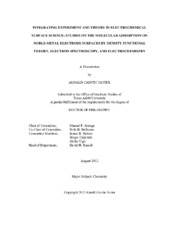| dc.description.abstract | Computational techniques based on density functional theory (DFT) and experimental methods based on electrochemistry (EC), electrochemical scanning tunneling microscopy (EC-STM), and high-resolution electron energy loss spectroscopy (HREELS) were employed to study the adsorption of (i) sulfuric acid on Pd(111), (ii) benzene on Pd(111), (iii) hydroquinone/benzoquinone on Pd(111), (iv) hydroquinone sulfonate/benzoquinone sulfonate on Pd(111), (v) 2,3-dimethylhydroquinone/2,3-dimethylbenzoquinone on Pd(111) and polycrystalline Pd, (vi) hydrogen on 1-6 monolayers (ML) of Pd deposited on a Pt(111) substrate, and (vii) a thiolated iron hydrogenase model complex on polycrystalline Au.
In situ EC-STM and DFT investigations of sulfuric acid on a Pd(111) surface indicated that two layers of water molecules and hydronium ions are assembled, non-co-planar with one another, between the rows of surface-coordinated sulfate anions; the layer that is slightly elevated is composed of hydronium counter cations.
The STM images of benzene chemisorbed on a Pd(111) electrode surface were simulated and the results suggested that, when the potential of the Pd electrode is held at 0.3 V, benzene is chemisorbed on a 3-fold site; while at 0.55 V, the molecule is adsorbed on a position between a 3-fold and a 2-fold site.
Computational and experimental results implied that at low concentrations, hydroquinone sulfonate undergoes oxidative chemisorption forming benzoquinone sulfonate (BQS) on the Pd(111) surface, BQS adopts a flat orientation in which the quinone ring is centered over a 2-fold site, and the C–H and C–S bonds are no longer co-planar with the quinone ring and are slightly tilted, directed away from the surface.
At very dilute concentrations, when hydroquinone (H_(2)Q) undergoes oxidative chemisorption producing benzoquinone oriented flat, albeit with a slight tilt, on the Pd(111) surface, the flat-adsorbed quinone ring is centered on a bridge site where the C_(2) axis is rotated 30degree from the [110] direction of the metal substrate, the p-oxygen atoms are located above two-fold sites, and the ring is slightly puckered with the C–H bonds tilted away from the surface at approximately 20degree.
When 2,3-dimethylH_(2)Q is chemisorbed on the Pd surface, at low concentrations, 2,3-dimethylH_(2)Q is oxidatively chemisorbed producing 2,3-dimethyl-1,4-benzoquinone oriented flat on the surface, the flat-adsorbed rings are centered above 2-fold sites wherein the C=O bonds are pointing 30degree from the [110] direction of the substrate, the para-oxygen atoms are located above bridge sites, the peripheral bonds are tilted away from the surface at ca. 20degree, and at higher concentrations, oxidative chemisorption occurs through activation of the ring’s C–H bonds yielding edge-oriented 2,3-dimethylH_(2)Q.
Electrochemistry and DFT results also implied that at 1-2 ML of Pd on Pt(111), hydrogen is only adsorbed on a hollow site while at 3 ML of Pd or more, atomic hydrogen may be chemisorbed on the 3-fold site or absorbed in the octahedral hole underneath the hollow site.
Using Au electrodes, an unbound iron hydrogenase analogue complex studied was found to slightly catalyze the H_(2) evolution process. However, when the complex was immobilized unto the Au surface, the electrocatalytic activity was greatly improved. | en |


